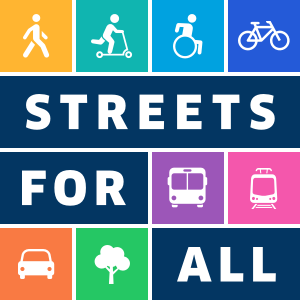Los Angeles Transportation 101
Have questions? Email us!
Source: DIY Great Streets Manual, Mayor’s Office
DEPARTMENTS & BUREAUS
When it comes to working on our streets, L.A. has a huge number of departments that get involved; lack of coordination can leave neighborhoods frustrated (ex. "I like the new bike lane but what about the broken sidewalk?")
EXPAND/COLLAPSE DETAIL ↓
The Los Angeles Department of Transportation (LADOT) controls the striping of a street (how the street space is used, which is indicated by paint). The General Manager of LADOT is appointed by the Mayor.
The Bureau of Street Services (StreetsLA) controls the surface of the street (including repaving) and handles concrete work, curb cuts, curbs, etc.
The Urban Forestry Division is underneath StreetsLA and is responsible for maintaining and planting trees.
The Bureau of Engineering (BoE) handles large capital projects, such as replacing bridges, or building new off street bike paths.
The Bureau of Street Lighting handles all street and path lighting for the city.
StreetsLA and BoE are both under the Department of Public Works. The Department is governed by the Board of Public Works, which has five members who are all appointed by the Mayor.
The Department of Recreation and Parks is responsible for maintaining parks within the City. The General Manager is appointed by the Mayor.
PLANS
The City has a number of plans that guide the built environment.
EXPAND/COLLAPSE DETAIL ↓
The Department of City Planning is responsible for coming up with the City's general plan, including its transportation element (in consultation with LADOT).
There are also community specific plans; for example, the Downtown Community Plan.
The circulation element of the City's general plan is called Mobility Plan 2035, and was adopted in 2015.
LADOT also has a Vision Zero program, which was supposed to eliminate traffic deaths by 2025. The City is woefully behind on this commitment; in fact, the problem is getting worse.
There are also specific Mayoral Executive Directives that guide transportation, such as former Mayor Garcetti's Executive Directive 25, part of LA's Green New Deal.
NUTS AND BOLTS
How does this all come together in the City's day-to-day?
EXPAND/COLLAPSE DETAIL ↓
Day-to-day, there are two relevent "buckets" of projects from a transportation point of view.
The first is your run-of-the-mill projects, such as annual street repaving. The city normally repaves about 500 miles of streets each year, but in FY23-24, it's only repaving about half of that due to budget cuts. During repaving, there is an opportunity to implement the bike lanes, bus lanes, traffic calming, and pedestrian improvements of the Mobility Plan for little to no cost (for example, the Venice Blvd Mobility Improvements project). However, City departments don't coordinate well, and opportunities to implement the mobility plan during repaving are often missed -- mostly due to LADOT being understaffed and not being able to do the needed design and outreach work associated with a project.
The second bucket are "capital projects" - typically grant funded, larger projects (for example, BoE's Hyperion Bridge project). LADOT-led projects are under the "LADOT Livable Streets" brand. The Bureau of Engineering also has a long list of capital projects, and StreetsLA has its own separate list of projects.
COUNCIL OFFICES
Everything revolves around council offices and they have incredible power to initiate, pause, or stop projects.
EXPAND/COLLAPSE DETAIL ↓
While City Departments may have their own methodologies that can dictate which projects get resources, which projects the City applies for grant funding, which streets will get repaved, and which streets will be prioritized, at the end of the day, the Council office has the final say.
Since there are more opportunities in the repaving schedule than LADOT resources allow for, it comes down to Council office priority.
If the Council office wants to focus on a specific corridor, they can direct departments (via a motion at council or otherwise) to do so (for example, CD10 and Venice Blvd).
If the Council office doesn't like a project, they can kill it (for example, Paul Koretz and Uplift Melrose).
The most successful council offices have seasoned staff that monitor grant opportunities, the repaving schedule, and current events to optimize outcomes and get new infrastructure, like bike and bus lanes, in the ground quickly.


